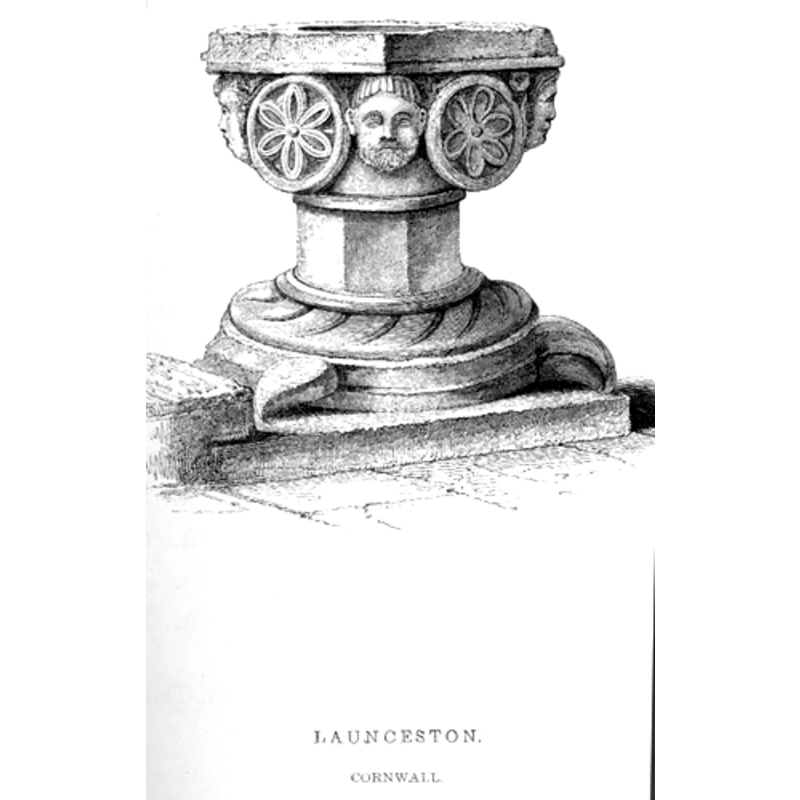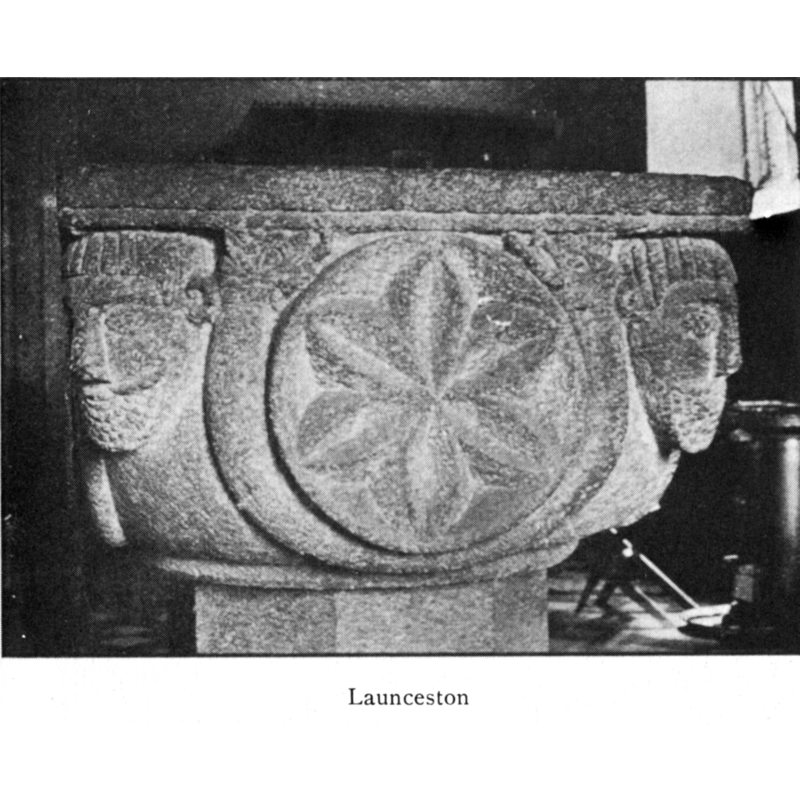St. Thomas-by-Launceston / St Thomas nr. Launceston

Image copyright © [in the public domain]
PD
Results: 5 records
B01: design element - motifs - floral - 6-petal - in a circle - 4
BH01: human figure - head - 4
LB01: design element - motifs - spur - 4
view of basin
INFORMATION
FontID: 07887THO
Object Type: Baptismal Font1
Church/Chapel: Parish Church of St. Thomas
Church Patron Saints: St. Thomas
Country Name: England
Location: Cornwall, South West
Directions to Site: Located just W of Launceston and of St Stephen-by-Launceston
Font Location in Church: Inside the church
Century and Period: 12th - 13th century, Late Norman / Transitional?
Workshop/Group/Artisan: Cornish font
Cognate Fonts: another dozen fonts of this type in Cornwall
Church Notes: According to GENUKI, this church supported a late-Norman or early-medieval leper hospital, hence its size and importance [www.genuki.org.uk]
Font Notes:
Click to view
Noted in Lysons (1806-1833) as one of a group of remarkable fonts in this county, "all nearly alike, being square at the top, with human heads at the corners, and circles inclosing [sic] stars on the sides, supported by serpents, &c." "The font is unusually large and of fine proportions constructed of polyphant stone". Several bibliographic sources (Bond, Cox & Harvey, Fryer, Paley, etc.) describe the Launceston font as one of a group of Norman fonts that display a head or mask at each of the four corners of the basin, while each of the sides is adorned with a large six-petal flower inside a round medallion. Paley (1844) even identifies the stone as "Exmill grey stone". However, on our on-site visit (July 1998) we found a Bodmin-type font - but in poor shape, completely recut - with the faces no longer identifiable [NB: could this be an error? Perhaps a reference to the font at Launceston?]. Since our latest bibliographic source are Cox & Harvey (1907) and Bond (1908), we assume that the font was re-cut in the 20th century. Noted in 'On the ancient stone fonts of Cornwall' (1851) as one of a group of "Fonts of very similar character are to be found in the churches of S. Nunn, Altarnun ; S. James, Jacobstowe ; S. Peter, Landrake ; S. Thomas by Launceston : and there are curious fonts of different character in the churches of SS. Mevan and Issi, Mevagissey ; S. Stephen by Launceston ; S. Andrew, Whitstone ; S. Marnarch, Lanreath, &c." Cox (1912) lists this as one of a group of Cornish fonts made from "hard Hicks Mill greystone", an "exceptionally fine Norman font […] with heads at angles and 4 circular ornaments on bowl ; bowl is 36 in. square and 20 in. deep on exterior." Listed in Stocker (1997) as one of a group of "early font bowls set within bases of successors". Stone (1955) describes it as the best example of the "Exe valley group" made up of thirteen such fonts. Illustrated in A Snap in Time [http://www.panoramio.com/photo/6818792] [accessed 25 November 2009].
MEDIUM AND MEASUREMENTS
Material: stone, [polyphant stone? Exmill grey stone? / Hicks Mill greystone?]
Font Shape: square (mounted)
Basin Interior Shape: round
Basin Exterior Shape: square
Rim Thickness: 3.5 cm*
Diameter (inside rim): 60 cm*
Basin Depth: 32.5 cm*
Basin Total Height: 50 cm*
Height of Base: 52.5 cm*
Font Height (less Plinth): 102.5 cm*
Trapezoidal Basin: 67.5 x 67.5 cm* / 90 x 90 cm**
Notes on Measurements: * measurements a/p Paley (1844), before the font was recut [cf. FontNotes] -- ** [given as "36 in. square" in Cox (1912), which does not make much change vis-à-vis Paley's earlier measurements]
LID INFORMATION
Material: wood
Apparatus: no
Notes: flat and round, with metal decoration and locking mechanism; date unknown
REFERENCES
"On the ancient stone fonts of Cornwall: a communication", 83 (April 1851) / New Series no. 47, Ecclesiologist, 1851, pp. 96-102; p. 99
Bond, Francis, Fonts and Font Covers, London: Waterstone, 1985 c1908
Clarke, Kate M., "The baptismal fonts of Devon -- Part V", 50, Report and Transactions of the Devonshire Association for the Advancement of Science, Literature and Art, 1918, pp. 583-587; p. 585
Clarke, Kate M., "The baptismal fonts of Devon -- Part VI", 51, Report and Transactions of the Devonshire Association for the Advancement of Science, Literature and Art, 1919, pp. 211-221; p. 214
Cox, John Charles, Cornwall, London: George Allen & Company, 1912
Cox, John Charles, English Church Furniture, New York: E.P. Dutton & Co., 1907
Friar, Stephen, The Sutton Companion to Churches, Thrupp, Stroud (Gloucs.): Sutton Publishing, 2003
Fryer, Alfred C., "A Group of Transitional-Norman Fonts", VII, British Archaeological Association Journal. New Series, [?], pp. 215ff; p. [?]
Lysons, Daniel, Magna Britannia, being a concise topographical account of the several counties of Great Britain, London: Printed for T. Cadell and W. Davies, 1806-1822
Paley, Frederick Apthorp, Illustrations of Baptismal Fonts, London, UK: John van Voorst, 1844
Stocker, D.A., "Fons et origo: The Symbolic Death and Resurrection of English Font Stones", I (1997b), Church Archaeology, 1997, pp. 17-25; p. 24
Stone, Lawrence, Sculpture in Britain: the Middle Ages, Harmondsworth: Penguin Books, 1955
